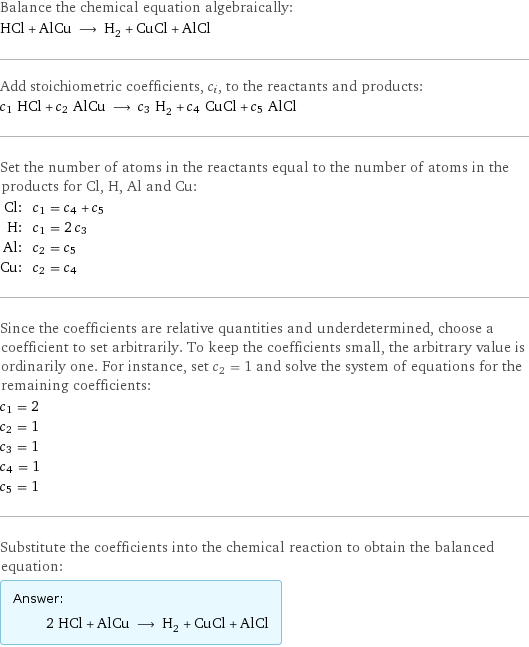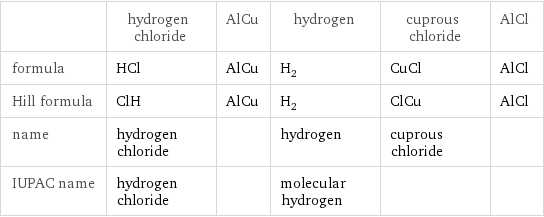Input interpretation

HCl hydrogen chloride + AlCu ⟶ H_2 hydrogen + CuCl cuprous chloride + AlCl
Balanced equation

Balance the chemical equation algebraically: HCl + AlCu ⟶ H_2 + CuCl + AlCl Add stoichiometric coefficients, c_i, to the reactants and products: c_1 HCl + c_2 AlCu ⟶ c_3 H_2 + c_4 CuCl + c_5 AlCl Set the number of atoms in the reactants equal to the number of atoms in the products for Cl, H, Al and Cu: Cl: | c_1 = c_4 + c_5 H: | c_1 = 2 c_3 Al: | c_2 = c_5 Cu: | c_2 = c_4 Since the coefficients are relative quantities and underdetermined, choose a coefficient to set arbitrarily. To keep the coefficients small, the arbitrary value is ordinarily one. For instance, set c_2 = 1 and solve the system of equations for the remaining coefficients: c_1 = 2 c_2 = 1 c_3 = 1 c_4 = 1 c_5 = 1 Substitute the coefficients into the chemical reaction to obtain the balanced equation: Answer: | | 2 HCl + AlCu ⟶ H_2 + CuCl + AlCl
Structures

+ AlCu ⟶ + + AlCl
Names

hydrogen chloride + AlCu ⟶ hydrogen + cuprous chloride + AlCl
Equilibrium constant
![Construct the equilibrium constant, K, expression for: HCl + AlCu ⟶ H_2 + CuCl + AlCl Plan: • Balance the chemical equation. • Determine the stoichiometric numbers. • Assemble the activity expression for each chemical species. • Use the activity expressions to build the equilibrium constant expression. Write the balanced chemical equation: 2 HCl + AlCu ⟶ H_2 + CuCl + AlCl Assign stoichiometric numbers, ν_i, using the stoichiometric coefficients, c_i, from the balanced chemical equation in the following manner: ν_i = -c_i for reactants and ν_i = c_i for products: chemical species | c_i | ν_i HCl | 2 | -2 AlCu | 1 | -1 H_2 | 1 | 1 CuCl | 1 | 1 AlCl | 1 | 1 Assemble the activity expressions accounting for the state of matter and ν_i: chemical species | c_i | ν_i | activity expression HCl | 2 | -2 | ([HCl])^(-2) AlCu | 1 | -1 | ([AlCu])^(-1) H_2 | 1 | 1 | [H2] CuCl | 1 | 1 | [CuCl] AlCl | 1 | 1 | [AlCl] The equilibrium constant symbol in the concentration basis is: K_c Mulitply the activity expressions to arrive at the K_c expression: Answer: | | K_c = ([HCl])^(-2) ([AlCu])^(-1) [H2] [CuCl] [AlCl] = ([H2] [CuCl] [AlCl])/(([HCl])^2 [AlCu])](../image_source/7d082de20c33229cb01bf4bd90b52360.png)
Construct the equilibrium constant, K, expression for: HCl + AlCu ⟶ H_2 + CuCl + AlCl Plan: • Balance the chemical equation. • Determine the stoichiometric numbers. • Assemble the activity expression for each chemical species. • Use the activity expressions to build the equilibrium constant expression. Write the balanced chemical equation: 2 HCl + AlCu ⟶ H_2 + CuCl + AlCl Assign stoichiometric numbers, ν_i, using the stoichiometric coefficients, c_i, from the balanced chemical equation in the following manner: ν_i = -c_i for reactants and ν_i = c_i for products: chemical species | c_i | ν_i HCl | 2 | -2 AlCu | 1 | -1 H_2 | 1 | 1 CuCl | 1 | 1 AlCl | 1 | 1 Assemble the activity expressions accounting for the state of matter and ν_i: chemical species | c_i | ν_i | activity expression HCl | 2 | -2 | ([HCl])^(-2) AlCu | 1 | -1 | ([AlCu])^(-1) H_2 | 1 | 1 | [H2] CuCl | 1 | 1 | [CuCl] AlCl | 1 | 1 | [AlCl] The equilibrium constant symbol in the concentration basis is: K_c Mulitply the activity expressions to arrive at the K_c expression: Answer: | | K_c = ([HCl])^(-2) ([AlCu])^(-1) [H2] [CuCl] [AlCl] = ([H2] [CuCl] [AlCl])/(([HCl])^2 [AlCu])
Rate of reaction
![Construct the rate of reaction expression for: HCl + AlCu ⟶ H_2 + CuCl + AlCl Plan: • Balance the chemical equation. • Determine the stoichiometric numbers. • Assemble the rate term for each chemical species. • Write the rate of reaction expression. Write the balanced chemical equation: 2 HCl + AlCu ⟶ H_2 + CuCl + AlCl Assign stoichiometric numbers, ν_i, using the stoichiometric coefficients, c_i, from the balanced chemical equation in the following manner: ν_i = -c_i for reactants and ν_i = c_i for products: chemical species | c_i | ν_i HCl | 2 | -2 AlCu | 1 | -1 H_2 | 1 | 1 CuCl | 1 | 1 AlCl | 1 | 1 The rate term for each chemical species, B_i, is 1/ν_i(Δ[B_i])/(Δt) where [B_i] is the amount concentration and t is time: chemical species | c_i | ν_i | rate term HCl | 2 | -2 | -1/2 (Δ[HCl])/(Δt) AlCu | 1 | -1 | -(Δ[AlCu])/(Δt) H_2 | 1 | 1 | (Δ[H2])/(Δt) CuCl | 1 | 1 | (Δ[CuCl])/(Δt) AlCl | 1 | 1 | (Δ[AlCl])/(Δt) (for infinitesimal rate of change, replace Δ with d) Set the rate terms equal to each other to arrive at the rate expression: Answer: | | rate = -1/2 (Δ[HCl])/(Δt) = -(Δ[AlCu])/(Δt) = (Δ[H2])/(Δt) = (Δ[CuCl])/(Δt) = (Δ[AlCl])/(Δt) (assuming constant volume and no accumulation of intermediates or side products)](../image_source/40b8582349ed341660c02238af16331c.png)
Construct the rate of reaction expression for: HCl + AlCu ⟶ H_2 + CuCl + AlCl Plan: • Balance the chemical equation. • Determine the stoichiometric numbers. • Assemble the rate term for each chemical species. • Write the rate of reaction expression. Write the balanced chemical equation: 2 HCl + AlCu ⟶ H_2 + CuCl + AlCl Assign stoichiometric numbers, ν_i, using the stoichiometric coefficients, c_i, from the balanced chemical equation in the following manner: ν_i = -c_i for reactants and ν_i = c_i for products: chemical species | c_i | ν_i HCl | 2 | -2 AlCu | 1 | -1 H_2 | 1 | 1 CuCl | 1 | 1 AlCl | 1 | 1 The rate term for each chemical species, B_i, is 1/ν_i(Δ[B_i])/(Δt) where [B_i] is the amount concentration and t is time: chemical species | c_i | ν_i | rate term HCl | 2 | -2 | -1/2 (Δ[HCl])/(Δt) AlCu | 1 | -1 | -(Δ[AlCu])/(Δt) H_2 | 1 | 1 | (Δ[H2])/(Δt) CuCl | 1 | 1 | (Δ[CuCl])/(Δt) AlCl | 1 | 1 | (Δ[AlCl])/(Δt) (for infinitesimal rate of change, replace Δ with d) Set the rate terms equal to each other to arrive at the rate expression: Answer: | | rate = -1/2 (Δ[HCl])/(Δt) = -(Δ[AlCu])/(Δt) = (Δ[H2])/(Δt) = (Δ[CuCl])/(Δt) = (Δ[AlCl])/(Δt) (assuming constant volume and no accumulation of intermediates or side products)
Chemical names and formulas

| hydrogen chloride | AlCu | hydrogen | cuprous chloride | AlCl formula | HCl | AlCu | H_2 | CuCl | AlCl Hill formula | ClH | AlCu | H_2 | ClCu | AlCl name | hydrogen chloride | | hydrogen | cuprous chloride | IUPAC name | hydrogen chloride | | molecular hydrogen | |
Substance properties

| hydrogen chloride | AlCu | hydrogen | cuprous chloride | AlCl molar mass | 36.46 g/mol | 90.528 g/mol | 2.016 g/mol | 99 g/mol | 62.43 g/mol phase | gas (at STP) | | gas (at STP) | solid (at STP) | melting point | -114.17 °C | | -259.2 °C | 430 °C | boiling point | -85 °C | | -252.8 °C | 1490 °C | density | 0.00149 g/cm^3 (at 25 °C) | | 8.99×10^-5 g/cm^3 (at 0 °C) | 4.145 g/cm^3 | solubility in water | miscible | | | | dynamic viscosity | | | 8.9×10^-6 Pa s (at 25 °C) | | odor | | | odorless | |
Units
